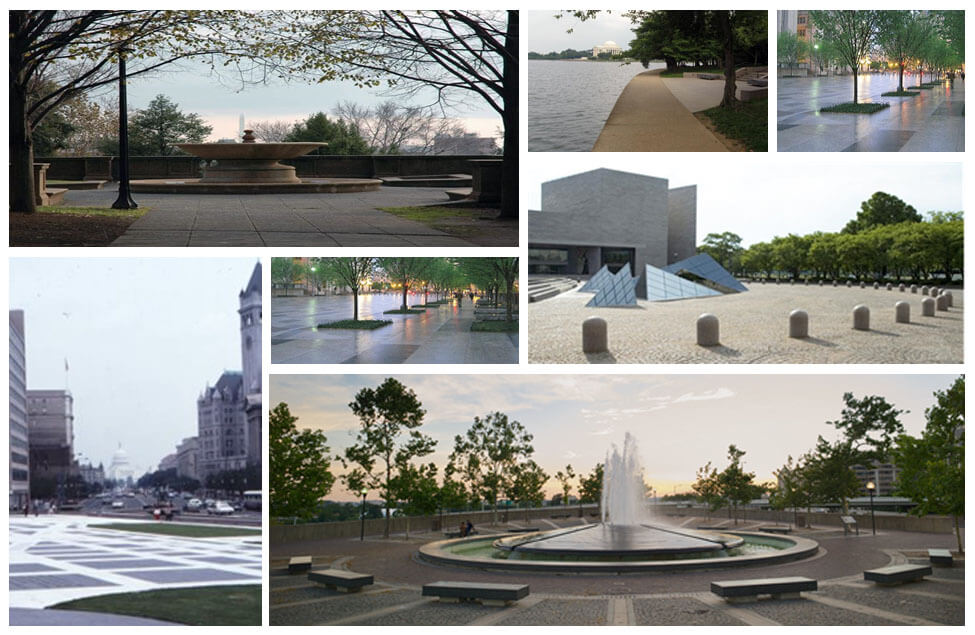
- By Surina Singh
- April 02, 2018
Adapting Designed Landscapes
On March 1, 2018, the National Capital Planning Commission (NCPC) released a draft of the federal Parks & Open Space Element for public review and comment through May 7, 2018. Three emerging issues influenced the update of this section of the Comprehensive Plan for the National Capital: adapting designed landscapes, balancing commemorative works within parks, and protecting Capper-Cramton parks. This post is the first in a three part blog series highlighting these topics.
A History of Designed Landscapes
While Washington, DC is largely known for its neoclassical architecture and landscapes that reflect the visions of the L’Enfant and McMillan Plans, it is also a region influenced by other eras that contribute to the city’s nationally recognized design character. These include the Italianate landscape of Meridian Hill Park; landscapes in the Victorian Garden tradition like President’s Park; and picturesque landscapes like Constitution Gardens or Arlington National Cemetery. Parks and plazas designed in the Modernist and Post-Modern period include landscapes along the Southwest Waterfront such as Banneker Park, public spaces along Pennsylvania Avenue such as Pershing Park and Freedom Plaza, and the landscapes for the Hirshhorn Sculpture Garden and John F. Kennedy Center for the Performing Arts.
A Need to Adapt
Designed landscapes face various pressures, ranging from alterations in the surrounding areas to changes in the way the landscapes are used and managed. Redevelopment on adjacent parcels, for example, can influence a landscape’s use, access, and circulation patterns. Changes can include the introduction of barriers such as highways and bridges, new traffic patterns that make pedestrian access difficult, or security features such as bollards or planters that modify pedestrian routes. An example where the function and use of a designed landscape has evolved over time is Banneker Park, originally designed as the terminus of 10th Street, SW. Because of new development along the Southwest Waterfront, the park is now an important connection between the waterfront and the National Mall.
Physical changes are not the only catalysts driving the need for designed landscapes to adapt. As urban environments develop and become denser, demographics shift and the way people use public spaces evolves. Designed landscapes and the needs they serve must evolve as well. Many of these urban spaces need to accommodate changes in use, new programmatic goals, infrastructure improvements, modified funding, and ongoing maintenance issues. An example where the program of an existing designed landscape evolved over time is Pershing Park. The historic landscape, designed by a prominent landscape architect to be used by nearby office workers, is now the proposed site for a new memorial with a national audience that will need to include contemplative space.
New Guidance in the Comprehensive Plan
The Parks & Open Space Element update recognizes the challenges associated with adapting designed landscapes and provides guidance on how to conduct an effective and appropriate assessment of proposed changes. Policies acknowledge that designed landscapes in urban areas must be successful public spaces. As such, they must accommodate a variety of users, incorporate seating and shaded areas, promote opportunities for social interaction, and maintain physical and visual connectivity to surrounding areas. Recognizing that designed landscapes represent a particular time and context that influenced their design, polices also acknowledge the importance of preserving significant character defining features and accommodating change in a manner sensitive to the original design.
After researching recent Commission reviews involving designed landscapes, NCPC staff found there are often challenges associated with applying competing planning principles and balancing design features from different design eras. The updated element emphasizes that while designed landscapes must adapt to changing conditions to meet contemporary needs, any modifications must also meet a high level of design quality because the changed landscape will continue to be a part of the region’s design legacy.
More Information
The updated draft Parks & Open Space Element is available for public review and comment through May 7, 2018. You can read the text and proposed policies, and learn about upcoming meetings and more on our dedicated Parks & Open Space webpage. Stay tuned for our next blog post in the series: Balancing Commemorative Works within Parks.
Part 2: Balancing Commemorative Works Within Parks Part 3: Protecting Capper-Cramton Parks Parks & Open Space Webpage Read the Document Submit A Comment


